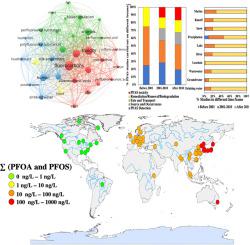Journal of Hazardous Materials ( IF 12.2 ) Pub Date : 2021-06-08 , DOI: 10.1016/j.jhazmat.2021.126361 Aditi Podder 1 , A H M Anwar Sadmani 1 , Debra Reinhart 1 , Ni-Bin Chang 1 , Ramesh Goel 2

|
Per and poly-fluoroalkyl substances (PFAS) have been recognized as contaminants of emerging concerns by the United States Environmental Protection Agency (US EPA) due to their environmental impact. Several advisory guidelines were proposed worldwide aimed at limiting their occurrences in the aquatic environments, especially for perfluorooctane sulfonic acid (PFOS) and perfluorooctanoic acid (PFOA). This review paper aims to provide a holistic review in the emerging area of PFAS research by summarizing the spatiotemporal variations in PFAS concentrations in surface water systems globally, highlighting the possible trends of occurrences of PFAS, and presenting potential human health impacts as a result of PFAS exposure through surface water matrices. From the data analysis in this study, occurrences of PFOA and PFOS in many surface water matrices were observed to be several folds higher than the US EPA health advisory level of 70 ng/L for lifetime exposure from drinking water. Direct discharge and atmospheric deposition were identified as primary sources of PFAS in surface water and cryosphere, respectively. While global efforts focused on limiting usages of long-chain PFAS such as PFOS and PFOA, the practices of using short-chain PFAS such as perfluorobutanoic acid (PFBA) and perfluorobutane sulfonic acid (PFBS) and PFAS alternatives increased substantially. These compounds are also potentially associated with adverse impacts on human health, animals and biota.
中文翻译:

全氟烷基物质和多氟烷基物质 (PFAS) 作为地表水中新出现的一种污染物:对其发生情况和毒性影响的跨界审查
由于其对环境的影响,全氟烷基和多氟烷基物质 (PFAS) 已被美国环境保护署 (US EPA) 确认为新出现的污染物。世界范围内提出了几项咨询指南,旨在限制它们在水生环境中的发生,特别是对于全氟辛烷磺酸 (PFOS) 和全氟辛酸 (PFOA)。本综述旨在通过总结全球地表水系统中 PFAS 浓度的时空变化,突出 PFAS 发生的可能趋势,并展示 PFAS 对人类健康的潜在影响,对 PFAS 研究的新兴领域进行全面回顾。通过地表水基质暴露。从本研究的数据分析来看,据观察,许多地表水基质中 PFOA 和 PFOS 的发生率比美国 EPA 健康建议水平 70 纳克/升(终生接触饮用水)高出数倍。直接排放和大气沉积分别被确定为地表水和冰冻圈中 PFAS 的主要来源。虽然全球努力的重点是限制全氟辛烷磺酸和全氟辛酸等长链全氟和多氟烷基物质的使用,但使用全氟丁酸 (PFBA) 和全氟丁烷磺酸 (PFBS) 等短链全氟和多氟烷基物质以及全氟和多氟烷基物质替代品的做法大幅增加。这些化合物还可能对人类健康、动物和生物群产生不利影响。直接排放和大气沉积分别被确定为地表水和冰冻圈中 PFAS 的主要来源。虽然全球努力的重点是限制全氟辛烷磺酸和全氟辛酸等长链全氟和多氟烷基物质的使用,但使用全氟丁酸 (PFBA) 和全氟丁烷磺酸 (PFBS) 等短链全氟和多氟烷基物质以及全氟和多氟烷基物质替代品的做法大幅增加。这些化合物还可能对人类健康、动物和生物群产生不利影响。直接排放和大气沉积分别被确定为地表水和冰冻圈中 PFAS 的主要来源。虽然全球努力集中在限制使用全氟辛烷磺酸和全氟辛酸等长链全氟和多氟烷基物质,但使用全氟丁酸 (PFBA) 和全氟丁烷磺酸 (PFBS) 等短链全氟和多氟烷基物质以及全氟和多氟烷基物质替代品的做法大幅增加。这些化合物还可能对人类健康、动物和生物群产生不利影响。











































 京公网安备 11010802027423号
京公网安备 11010802027423号